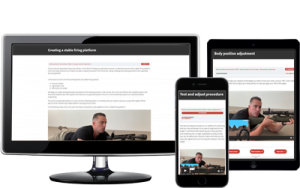No products in the cart.


In the last post we discussed how how to naturally align your weapon to the target for greater accuracy by moving your body.
In this post we are also going to be discussing an important concept of natural alignment: Breathing.
When you have the rifle butt resting in your shoulder it becomes connected to your body.
Once connected, it will move when your body moves.
When you breathe in your lungs fill with air and your chest expands.
Similarly when you breathe out air leaves your lungs and your chest compresses.
This movement although quite small will have a significant impact on your point of aim – moving it up and down with every breath.
In order the ensure perfect and consistent alignment to the target, you need to select a point in this breathing cycle to take your shot.
When you are taking slow deliberate shots and have the luxury of time, the best time to take a shot is when you have exhaled all the air from your lungs.
This is for two reasons:
When your diaphragm is full your “contact pad” is reduced and this can cause a rolling effect for your upper body.
You should avoid firing at this point and instead aim to release the shot at full exhalation when your contact pad is increased; this will give your position more stability.
A good analogy to use is a car tire.
When the tire is full of air it rolls easily, but when the tire is flat it is harder to roll.
When you shoot you want to be a flat car tire.

Over the years I have heard and seen some weird recommendations about shooting and breathing.
I have come across recommendations for shooting when you have breathed out half your air, or on three quarters of your air… don’t do this.
Unless you are some kind of half robot with an accurate air regulator, you will never be able to consistently stop on a half full lung.
The small deviations will mean that every breath you take your point of aim will be slightly higher or lower depending on where you stop your breath.
A tell tale sign of this is vertical grouping patterns (we cover this in our article on grouping).
The only consistent point is an empty lung.
Even a full lung is not consistent enough, as you naturally stop inhaling at a point where you can breath in more air.
Don’t believe me? Take a relaxed breath in and stop at a natural point… then without exhaling, breath in a little more, then a little more…
Now even though this is uncomfortable, the point at which you stop will not be the same every time.
Contrast this to breathing out, you will stop at a more more predictable point every time.
The following is the same breathing cycle I have used throughout my career in the Army and it has served me well.
Once you are aligned to the target:
That’s it… pretty simple. Now there is one more thing that you need to know when using this technique and it is where a lot of new shooters go wrong.
When you follow this technique at step 5 above, if you hold your breath for any longer than the “2…3… ” cadence and don’t release the shot, things will go wrong.
What occurs is your vision will to go blurry and even if you have a stable firing platform, your weapon will start to wobble.
This is because your brain will start to experience oxygen deficiency because of a lack of oxygen in your system.
The fix for this is simple… just start the whole breathing cycle again.
If you try to get the shot off without another breath it will be more luck than skill if the bullet hits where you want it to.
The slight movement of our chest when breathing will affect your point of aim.
For this reason we recommend taking a shot at the same point in your breathing cycle.
The best point in the breathing cycle is the empty lung, this is because it is when your position is the most stable (flat car tire) and provides the most consistent point of reference.
Correct breathing technique is so important, that in the Virtual-Shot open range shooting analytics we included a vertical shot analysis graph so that you can analyze the breathing pattern of each shot.
Here is a screen shot of the analysis and what a correct breathing pattern should look like:

Now that you have a good understanding of natural alignment and breathing, there is a pre-shot procedure that has been developed to tie both of these principles together for perfect alignment.
It is called the “Test and Adjust Procedure”, and it the the best pre-shot routine to ensure you are naturally aligned to the target.

 Find Out More
Find Out More